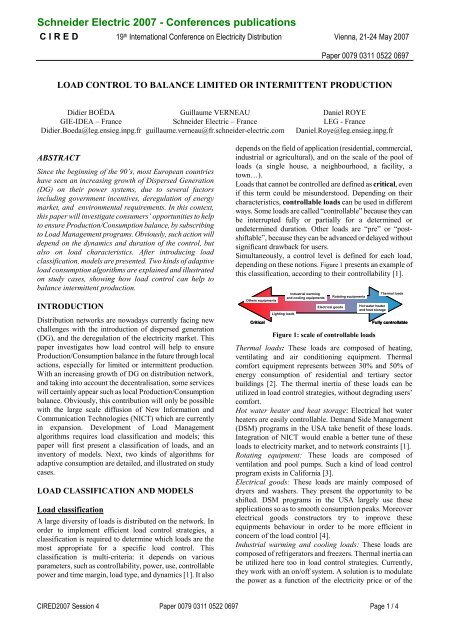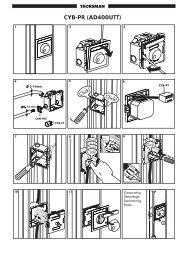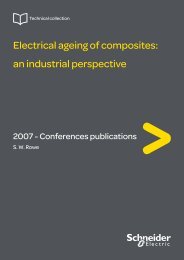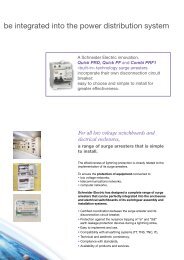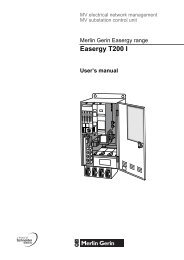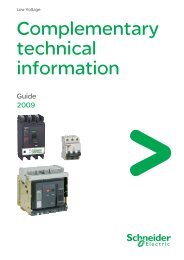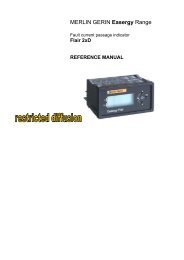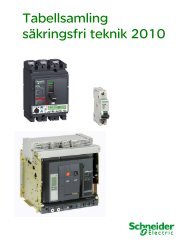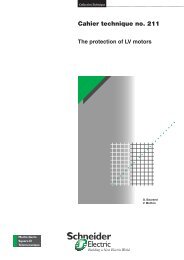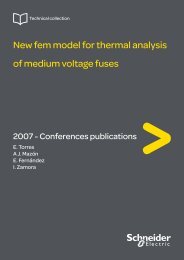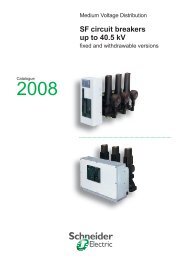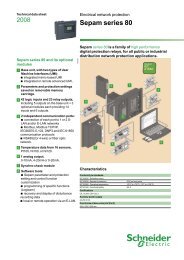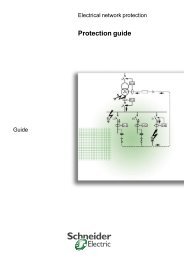Load control to balance limited or intermittent ... - Schneider Electric
Load control to balance limited or intermittent ... - Schneider Electric
Load control to balance limited or intermittent ... - Schneider Electric
You also want an ePaper? Increase the reach of your titles
YUMPU automatically turns print PDFs into web optimized ePapers that Google loves.
<strong>Schneider</strong> <strong>Electric</strong> 2007 - Conferences publications<br />
C I R E D <br />
<br />
<br />
<br />
LOAD CONTROL TO BALANCE LIMITED OR INTERMITTENT PRODUCTION<br />
Didier BOËDA Guillaume VERNEAU Daniel ROYE<br />
GIE-IDEA – France <strong>Schneider</strong> <strong>Electric</strong> – France LEG - France<br />
Didier.Boeda@leg.ensieg.inpg.fr guillaume.verneau@fr.schneider-electric.com Daniel.Roye@leg.ensieg.inpg.fr<br />
ABSTRACT<br />
Since the beginning of the 90’s, most European countries<br />
have seen an increasing growth of Dispersed Generation<br />
(DG) on their power systems, due <strong>to</strong> several fac<strong>to</strong>rs<br />
including government incentives, deregulation of energy<br />
market, and environmental requirements. In this context,<br />
this paper will investigate consumers’ opp<strong>or</strong>tunities <strong>to</strong> help<br />
<strong>to</strong> ensure Production/Consumption <strong>balance</strong>, by subscribing<br />
<strong>to</strong> <strong>Load</strong> Management programs. Obviously, such action will<br />
depend on the dynamics and duration of the <strong>control</strong>, but<br />
also on load characteristics. After introducing load<br />
classification, models are presented. Two kinds of adaptive<br />
load consumption alg<strong>or</strong>ithms are explained and illustrated<br />
on study cases, showing how load <strong>control</strong> can help <strong>to</strong><br />
<strong>balance</strong> <strong>intermittent</strong> production.<br />
INTRODUCTION<br />
Distribution netw<strong>or</strong>ks are nowadays currently facing new<br />
challenges with the introduction of dispersed generation<br />
(DG), and the deregulation of the electricity market. This<br />
paper investigates how load <strong>control</strong> will help <strong>to</strong> ensure<br />
Production/Consumption <strong>balance</strong> in the future through local<br />
actions, especially f<strong>or</strong> <strong>limited</strong> <strong>or</strong> <strong>intermittent</strong> production.<br />
With an increasing growth of DG on distribution netw<strong>or</strong>k,<br />
and taking in<strong>to</strong> account the decentralisation, some services<br />
will certainly appear such as local Production/Consumption<br />
<strong>balance</strong>. Obviously, this contribution will only be possible<br />
with the large scale diffusion of New Inf<strong>or</strong>mation and<br />
Communication Technologies (NICT) which are currently<br />
in expansion. Development of <strong>Load</strong> Management<br />
alg<strong>or</strong>ithms requires load classification and models; this<br />
paper will first present a classification of loads, and an<br />
inven<strong>to</strong>ry of models. Next, two kinds of alg<strong>or</strong>ithms f<strong>or</strong><br />
adaptive consumption are detailed, and illustrated on study<br />
cases.<br />
LOAD CLASSIFICATION AND MODELS<br />
<strong>Load</strong> classification<br />
A large diversity of loads is distributed on the netw<strong>or</strong>k. In<br />
<strong>or</strong>der <strong>to</strong> implement efficient load <strong>control</strong> strategies, a<br />
classification is required <strong>to</strong> determine which loads are the<br />
most appropriate f<strong>or</strong> a specific load <strong>control</strong>. This<br />
classification is multi-criteria: it depends on various<br />
parameters, such as <strong>control</strong>lability, power, use, <strong>control</strong>lable<br />
power and time margin, load type, and dynamics [1]. It also<br />
depends on the field of application (residential, commercial,<br />
industrial <strong>or</strong> agricultural), and on the scale of the pool of<br />
loads (a single house, a neighbourhood, a facility, a<br />
<strong>to</strong>wn…).<br />
<strong>Load</strong>s that cannot be <strong>control</strong>led are defined as critical, even<br />
if this term could be misunders<strong>to</strong>od. Depending on their<br />
characteristics, <strong>control</strong>lable loads can be used in different<br />
ways. Some loads are called “<strong>control</strong>lable” because they can<br />
be interrupted fully <strong>or</strong> partially f<strong>or</strong> a determined <strong>or</strong><br />
undetermined duration. Other loads are “pre” <strong>or</strong> “postshiftable”,<br />
because they can be advanced <strong>or</strong> delayed without<br />
significant drawback f<strong>or</strong> users.<br />
Simultaneously, a <strong>control</strong> level is defined f<strong>or</strong> each load,<br />
depending on these notions. Figure 1 presents an example of<br />
this classification, acc<strong>or</strong>ding <strong>to</strong> their <strong>control</strong>lability [1].<br />
Others equipments<br />
Critical<br />
Lighting loads<br />
Industrial warming<br />
and cooling equipments<br />
<strong>Electric</strong>al goods<br />
Rotating equipments<br />
Hot water heater<br />
and heat s<strong>to</strong>rage<br />
Figure 1: scale of <strong>control</strong>lable loads<br />
Thermal loads<br />
Fully <strong>control</strong>lable<br />
Thermal loads: These loads are composed of heating,<br />
ventilating and air conditioning equipment. Thermal<br />
comf<strong>or</strong>t equipment represents between 30% and 50% of<br />
energy consumption of residential and tertiary sec<strong>to</strong>r<br />
buildings [2]. The thermal inertia of these loads can be<br />
utilized in load <strong>control</strong> strategies, without degrading users’<br />
comf<strong>or</strong>t.<br />
Hot water heater and heat s<strong>to</strong>rage: <strong>Electric</strong>al hot water<br />
heaters are easily <strong>control</strong>lable. Demand Side Management<br />
(DSM) programs in the USA take benefit of these loads.<br />
Integration of NICT would enable a better tune of these<br />
loads <strong>to</strong> electricity market, and <strong>to</strong> netw<strong>or</strong>k constraints [1].<br />
Rotating equipment: These loads are composed of<br />
ventilation and pool pumps. Such a kind of load <strong>control</strong><br />
program exists in Calif<strong>or</strong>nia [3].<br />
<strong>Electric</strong>al goods: These loads are mainly composed of<br />
dryers and washers. They present the opp<strong>or</strong>tunity <strong>to</strong> be<br />
shifted. DSM programs in the USA largely use these<br />
applications so as <strong>to</strong> smooth consumption peaks. M<strong>or</strong>eover<br />
electrical goods construc<strong>to</strong>rs try <strong>to</strong> improve these<br />
equipments behaviour in <strong>or</strong>der <strong>to</strong> be m<strong>or</strong>e efficient in<br />
concern of the load <strong>control</strong> [4].<br />
Industrial warming and cooling loads: These loads are<br />
composed of refrigera<strong>to</strong>rs and freezers. Thermal inertia can<br />
be utilized here <strong>to</strong>o in load <strong>control</strong> strategies. Currently,<br />
they w<strong>or</strong>k with an on/off system. A solution is <strong>to</strong> modulate<br />
the power as a function of the electricity price <strong>or</strong> of the


